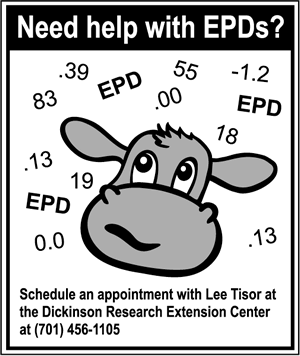
Kris Ringwall
Beef Talk
Numbers can challenge, but don’t give up.
Here is an invitation. Just call if you want to schedule an appointment to review or better understand the numerous numbers associated with expected progeny differences (EPDs). Even when well understood, the EPD numbers can be daunting, even overwhelming.
Navigating the Web pages of the breed associations that are entrusted to analyze and present the data can be daunting, and trying to locate and download the data on numerous devices may add to the frustration. However, don’t give up, because the data is far too valuable to not use the numbers.
While teaching sessions on how to access and use EPD data, I am reminded that numbers are not something everyone is comfortable using. However, that does not negate the need to use them, so just ask for help.
Focus is a good term. Perhaps we can add the words patience and some resilience.
As one starts to review bull sale books, learn to look for the bull’s registration number. The bull’s registration number is no different than a vehicle identification number (VIN) for a car or pickup. In fact, if one was to apply for a car or pickup loan, the VIN number is required. When purchasing a car or pickup, why not use the VIN number to obtain all the available data that applies to the vehicle?
Using the data
 The same is true for the registration number of the bull. The appropriate breed association will have all the submitted data on that bull and will provide the information fairly easily. Any Internet search engine will locate the breed association website that applies to your bull, so find it, click on it and open up the Web page.
The same is true for the registration number of the bull. The appropriate breed association will have all the submitted data on that bull and will provide the information fairly easily. Any Internet search engine will locate the breed association website that applies to your bull, so find it, click on it and open up the Web page.
Generally, one can find fairly quickly a data search function or tab to enter the registration number. Enter it, click on submit and read the report. In the case of VIN numbers, one may find out that the vehicle has traveled a lot farther than you thought it had, or perhaps experienced some mishaps that may have not been mentioned by the seller.
Bull registration numbers provide a similar function because the association will provide the relevant data on the bull’s owner(s), pedigree, performance and other associated information. During the “How to buy bulls by the numbers” workshop sessions, participants generally become very intense once they realize just how much of a bull’s information is available.
Several associations even allow for lists of bulls to be entered at one time and the appropriate information will be printed for the entire list. There is no delay, so look at the screen or hit the print button to generate a customized bull sale book.
The Angus website actually has a function that will graph the individual EPDs for a bull. This will allow you to quickly evaluate the predicted EPDs for a particular bull.
During the workshops and after reviewing the website and the various information presented, the discussion soon moved to the concept of listing or presenting the bull’s ranking by using percentiles. However, understanding percentile rankings for each EPD trait for a given bull is difficult, so select a few traits and review how the bull ranks.
During the workshops, I used birth weight, weaning weight, yearling weight, marbling and ribeye area EPDs. These five EPDs represent five very basic functions related to output within a beef herd. In other words, growth along with a decent carcass.
Now check each bull’s individual trait value and see how the bull ranks within the breed by using the EPD percentile table on the chosen breed association’s website. Sometimes these values are printed in the sale book, but seldom are they readily available.
Car dealers will tell you the miles per gallon (MPG) that a particular car is rated, but usually you will have to ask twice how the car’s MPG rates against a competing car. That is exactly the question we are asking about a bull. In this case, we are comparing bulls and asking how they rate within the breed for the various traits we are interested in buying.
In essence, we have studied and admired the phenotype of several bulls that meet our desired appearance, so if we are going to buy bulls at today’s prices, why not make sure that the bulls are carrying the genes we want and represent the top bulls within the breed? That is what the percentile tables provide. However, lots of numbers lead to confusion, so don’t forget my invitation. If confused about the numbers, call Lee Tisor at 701-567-1105 to schedule a review of your bull’s numbers.
May you find all your ear tags.

Editor’s Note: Kris Ringwall is a North Dakota State University Extension Service livestock specialist and the Dickinson Research Extension Center director. For more information, contact him at 1041 State Ave., Dickinson, ND 58601, or go to www.ag.ndsu.edu/news/columns/beeftalk/.
[Click here to go to the top of the page.]





